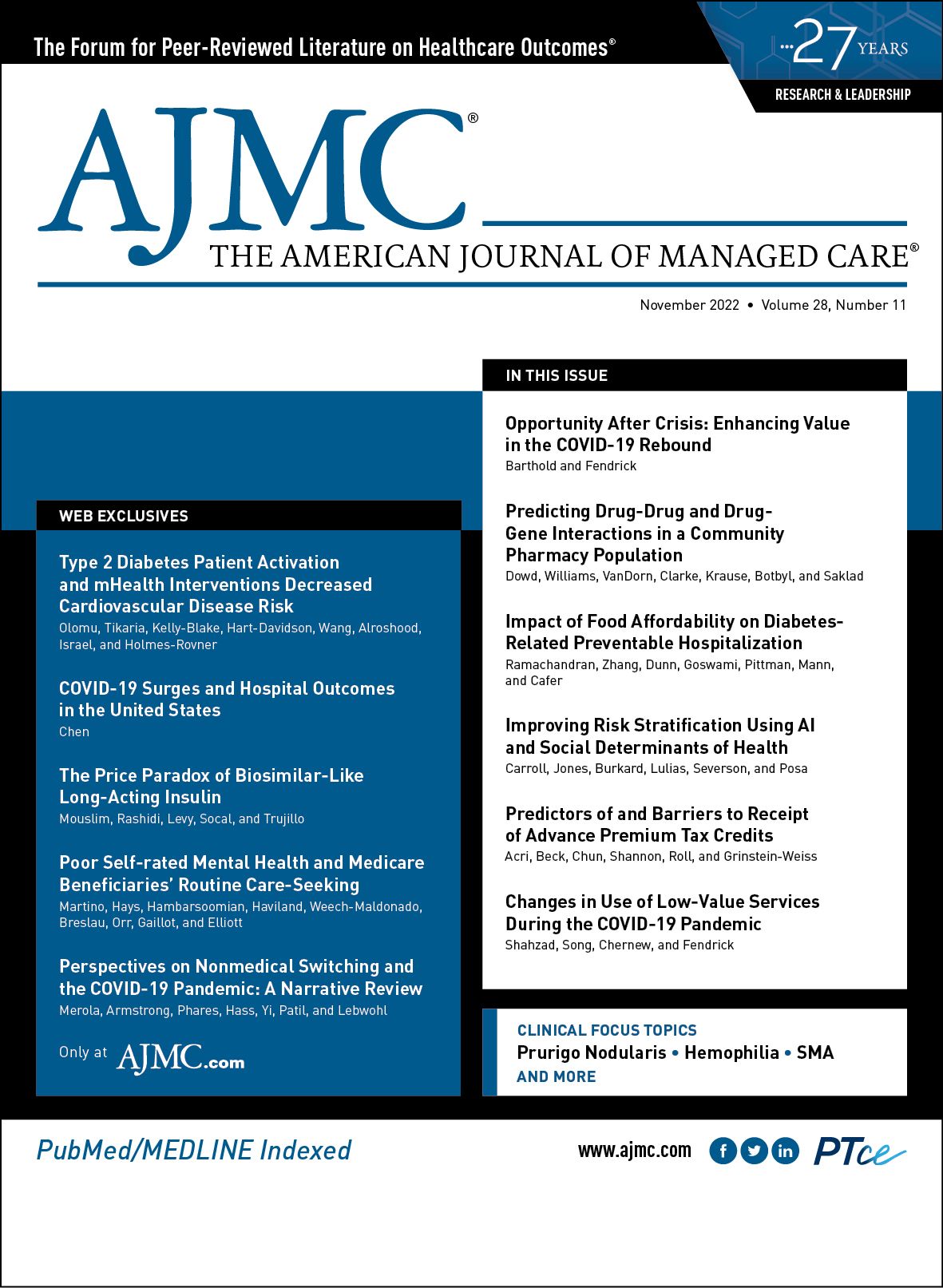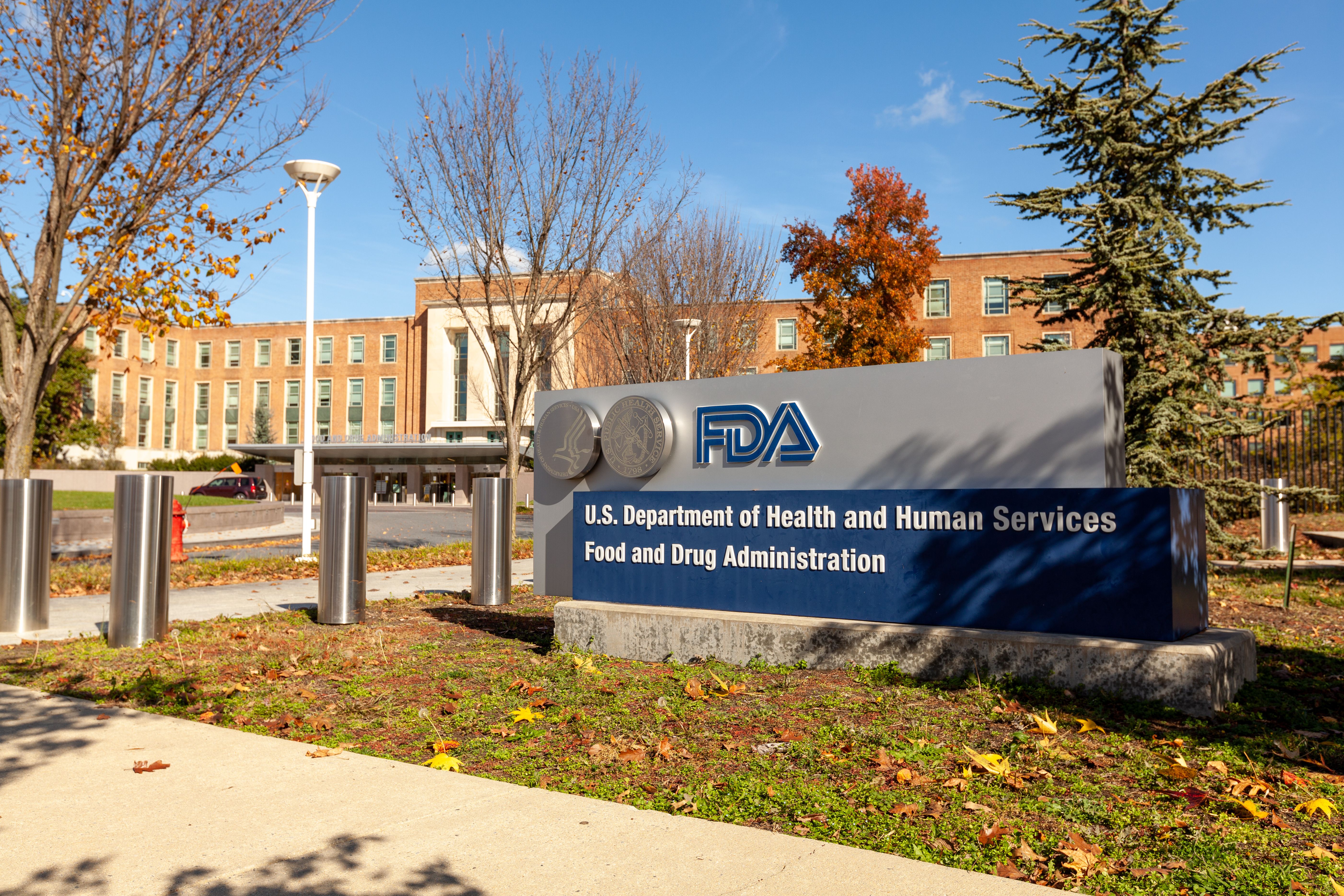Publication
Article
The American Journal of Managed Care
Predicting Drug-Drug and Drug-Gene Interactions in a Community Pharmacy Population
Author(s):
The probability of drug interactions increases when genetic polymorphisms are considered, indicating that pharmacogenetic assessment may be useful in predicting the presence and severity of interactions.
ABSTRACT
Objectives: Drug-drug interactions (DDIs) are among the most common causes of adverse drug reactions and are further complicated by genetic variants of drug-metabolizing enzymes. The aim of this study is to quantify and describe potential DDIs, drug-gene interactions (DGIs), and drug-drug-gene interactions (DDGIs) in a community-based population.
Study Design: This was an analysis of deidentified retail pharmacy prescription data for 4761 individuals.
Methods: Data were first assessed for DDIs, and individuals were stratified to a risk category using the logic of a commercially available digital DDGI tool. To calculate the frequency of potential DGIs and DDGIs, genotypes were imputed and randomly allocated to the cohort 100 times via Monte Carlo simulation according to each variant’s frequency in the general population.
Results: The probability of a DDI of any impact was 26.0% and increased to 49.6% (95% CI, 48.4%-50.7%) when drug-metabolizing phenotypes were ascribed according to the distribution of variants of 11 genes as found in a Caucasian population. There was a 7.8% probability of major DDIs, which increased to a 10.1% (95% CI, 9.5%-10.8%) probability with the addition of genetic contributions. The probability of DDGIs of any impact was correlated with the number of medications. Antidepressants, antiemetics, blood products and modifiers, analgesics, and antipsychotics had the highest probability of DDGIs.
Conclusions: The probability of drug interaction risk increased when phenotypes associated with genetic polymorphisms were attributed to the population. These data suggest that pharmacogenomic assessment may be useful in predicting drug interactions and severity when evaluating patient medication profiles.
Am J Manag Care. 2022;28(11):566-571. https://doi.org/10.37765/ajmc.2022.89259
Takeaway Points
Prescription data from a community-based cohort were assessed for drug-drug, drug-gene, and drug-drug-gene interactions by randomly allocating genotypes to the population according to each gene’s frequency in the general population.
- When ascribing genetic polymorphisms, there was a 90.7% increase in the estimated probability of an interaction of any impact and a 30.4% increase in the probability of a major impact.
- Antidepressants, antiemetics, blood products and modifiers, analgesics, and antipsychotics had the highest probability of drug-drug-gene interactions.
- A risk assessment model based on the prevalence of pharmacogenetic variants within a population may be used to predict drug interaction risk and severity.
Approximately 50% of individuals in the United States report taking at least 1 prescribed medication, according to data published by the National Center for Health Statistics. Furthermore, 24% of individuals are prescribed 3 or more prescription medications and approximately 13% reported the use of 5 or more prescription medications within the past 30 days.1 In total, approximately 3.8 billion prescriptions were filled at pharmacies in the United States in 2019.2 Unfortunately, many patients will experience negative effects of medication usage either in the form of adverse drug reactions (ADRs) or medication inefficacy.3 ADRs are common and are associated with increased morbidity, mortality, and resource utilization. Data published by the American Society of Pharmacovigilance show that ADRs are linked to 1 million emergency department visits, 2.2 million hospital admissions, and approximately $136 billion in health care costs on an annual basis.4 Although the true mortality burden of ADRs is unknown due to methodologic considerations, it has been estimated that ADRs may be as high as the fourth leading cause of death.5
Drug-drug interactions (DDIs) are among the most common causes of ADRs. DDIs may result from pharmacodynamic interaction, in which medications can directly impact the effects of concomitant drugs at specific receptors or other targets. An example of such interaction would be the development of serotonin syndrome with the dual use of selective serotonin reuptake inhibitors and other serotonergic medications. More commonly, interactions arise from the propensity of an agent to affect the absorption, distribution, metabolism, or excretion of other concomitantly administered drugs.6-8 Up to 22% of all patients taking medications are predicted to have DDIs, with estimates of up to 31% in the elderly population.9
In addition to DDIs, genetic variation can cause alterations in key proteins or enzymes that result in clinically significant changes in medication exposure.10 Although DDIs are routinely assessed in clinical practice, drug-gene interactions (DGIs) and drug-drug-gene interactions (DDGIs), defined as the synergistic effects of DDIs and DGIs, are not.11 However, the influence of genetics on medication interactions is increasingly being recognized, and many FDA drug labels now include cautions or dosing guidance based on DGIs or DDGIs.12 For example, the FDA label for aripiprazole recommends a 50% reduction in individuals genetically predisposed to slow metabolism of the drug (ie, a DGI), with a further dosage reduction to 25% if the patient is taking other medications that also reduce metabolism (ie, a DDGI).13 It has been estimated that DGIs and DDGIs account for 34% of significant medication interaction risk.11
The science of assessing how a patient’s genetics affect drug efficacy and safety is termed pharmacogenomics (PGx).14 This field of study is increasingly being incorporated into clinical practice, particularly in certain disciplines such as oncology, psychiatry, and cardiovascular medicine. The incorporation of PGx into clinical practice has shown great promise and has been associated with decreases in health care resource utilization and hospitalizations in certain settings.15-17 Despite this, drugs are commonly utilized without knowledge of an individual’s genetic makeup. As such, the aim of this study is to quantify and describe potential DDIs, DGIs, and DDGIs in a cohort typical of an outpatient, community-based patient population in the United States.
METHODS
Medication Data
A regional commercial pharmacy, Express Rx, provided deidentified prescription data from 4 retail locations in March 2020. The data set, which was transferred to Genomind, Inc, consisted of deidentified patient information, including age and all medications and their dosage. Medications were assessed for DDIs, DGIs, and DDGIs based on logic incorporated into a commercially available DDGI software program (Genomind). The study received an exemption from provision of informed consent from an investigational review board (Advarra).
DDGI Software
The software incorporates variants of 9 pharmacokinetic (PK) genes (ABCB1 [rs2032583, C3435T], CYP1A2, CYP2B6, CYP2C19, CYP2C9, CYP2D6, CYP3A4/5, UGT1A4,and UGT2B15) and 2 pharmacodynamic (PD) genes (HLA-A*31:01 and HLA-B*15:02) from a commercial PGx test. This proprietary tool assesses PK and PGx information to assess and quantify DDIs, DGIs, and DDGIs. The software incorporates findings from the primary PGx literature, as well as data from the FDA, the Pharmacogenomics Knowledgebase (PharmGKB), the Clinical Pharmacogenetics Implementation Consortium (CPIC), and the Dutch Pharmacogenetics Working Group (DPWG).12,18-21 The software defines medications as primary or secondary substrates and minor, moderate, or strong inhibitors or inducers of the various PK pathways, based on the above-referenced data input. DDIs, DGIs, and DDGIs are calculated and stratified into minor, moderate, or major risk categories dependent on the significance of the calculated interaction (Figure 112,18-22). These category names were chosen to correlate with FDA nomenclature defining DDI inhibition or induction severity.22 More detailed drug-specific information is provided in the software with hyperlinks to relevant FDA labels or CPIC and DPWG guidelines. As of the time of this data analysis, this software includes information on 630 drugs, corresponding to more than 99% of all Medicare prescriptions written in the United States from 2015 to 2019.
DDI Assessment
To calculate and assess potential DDIs in the population, medication combinations were assessed for interaction under the assumption that all genotypes were wild type for the CYP450, UGT, and ABCB1 genes and negative for the HLA-A and HLA-B genes.
DDGI Assessment
To calculate the frequency of potential DDGIs, phenotypes were imputed and randomly allocated according to each gene’s frequency in the general population. Based on the reported demographics of each Express Rx retail location,23 the population was assumed to be primarily of Caucasian ethnicity, and phenotype frequencies denoted in PharmGKB for the European population were utilized for imputation24 (Table 124,25). Given a population of presumed predominant European ancestry, HLA-B frequencies were assigned to 0%. CYP3A4/5 activity was defined as an estimated composite of CYP3A4 and CYP3A5 activities in the general population using a phenotyping system described elsewhere.25 Random allocation of phenotypes was conducted 100 times per patient using Monte Carlo simulation.
Statistical Analysis
To assess the probability of a DDGI impact in the population when ascribing a random pharmacogenomic phenotype to a patient, the binomial probability of observing an impact of any severity and the probability of a major impact was first calculated within each patient using the 100 random patient-level phenotypes. The means and associated 95% CIs of the 4761 patient-level probabilities were then calculated to obtain population-level probabilities of impact. These probabilities were calculated by age group (< 65 and ≥ 65 years) and within United States Pharmacopeia (USP) drug classifications. Additionally, the probability of impact was calculated based on the number of drugs that each patient was prescribed (3, 4, 5, 6, and ≥ 7 drugs).
RESULTS
Prescription data for 4761 individuals were assessed. The meannumber of medications prescribed was 3.4 in patients younger than 65 years and 5.3 in patients 65 years and older. In total, 4730 composite DDIs were identified in the cohort, with many patients having multiple interactions. These DDIs were composed of 884 major, 2141 moderate, and 1705 minor interactions.
In the total population, there was a 26.0% probability of individuals experiencing an interaction of any severity (minor, moderate, or major) when assessing only DDIs, including a 7.8% rate of major-impact DDIs. When simulated genetic polymorphisms were ascribed to the population, the probability of a DDGI of any impact increased to 49.6% (95% CI, 48.4%-50.7%), and the probability of a major interaction increased to 10.1% (95% CI, 9.5%-10.8%) (Table 2). These increases in interaction rates represent a 90.7% relative increase in the estimated probability of an interaction of any impact and a 30.4% relative increase in the probability of an interaction of major impact. Of the predicted major interactions, 99.4% were due to enzyme inhibition or reduced enzyme metabolism, which would be expected to result in a clinically significant increase in drug blood levels (or a clinically significant decrease of active metabolite for drugs considered to be prodrugs).
The probability of an interaction of any impact in individuals younger than 65 years was 24.3% when assessing DDIs, which increased to 48.7% (95% CI, 47.0%-50.4%) when genetic polymorphisms were imputed. Similar trends were seen in the population 65 years and older, with a probability of interaction of 38.7% when assessing DDIs and an increase to 64.4% (95% CI, 61.1%-67.2%) when genetic variants were ascribed. In the population younger than 65 years, the probability of a major DDI was 7.2% and increased to 9.6% (95% CI, 8.7%-10.6%) with genetic imputation. Similarly, in those 65 years and older, the probability of a major interaction related to DDIs was 12.1% and increased to 14.2% (95% CI, 12.2%-16.2%) once DDGIs were considered (Table 2).
Furthermore, the probability of DDGIs of any impact was directly correlated with the number of prescribed medications in the cohort. In patients prescribed 3 medications, there was a 58.6% (95% CI, 55.0%-62.1%) probability of interaction, with probabilities increasing to 66.2% (95% CI, 62.2%-70.2%), 76.6% (95% CI, 72.5%-80.8%), 85.4% (95% CI, 81.7%-89.3%), and 94.2% (95% CI, 93.0%-95.5%) in patients prescribed 4, 5, 6, or 7 or more medications, respectively (Figure 2).
When stratifying interactions based on USP drug classification, antidepressants, antiemetics, blood products and modifiers, analgesics, and antipsychotics had the highest mean probability of DDGIs with any impact, whereas antiparasitic medications, antiemetics, antidepressants, analgesics, and antipsychotics had the highest probability of major DDGIs in the patient cohort (Figure 3). Of the medications most implicated in potential major DDGIs, antiparasitics, antiemetics, antidepressants, analgesics, and antipsychotics accounted for 0.24%, 2.9%, 8.2%, 8.4%, and 0.87% of the total prescriptions filled in the cohort, respectively.
DISCUSSION
The field of PGx has always held the promise of personalizing and optimizing medication management, and research has supported PGx in terms of clinical validity and utility. A recent meta-analysis of prospective, randomized controlled trials assessing PGx-guided decision support tools used in the treatment of major depressive disorder showed that PGx-guided therapy was 71% more likely to result in symptom remission than treatment as usual (TAU).26 An additional systematic review and meta-analysis in a wide range of care settings showed a 50% decrease in all-cause hospitalizations and a nearly 2-fold increase in medication changes following PGx-guided therapy compared with TAU.17 Similar reductions in hospitalizations and/or health care utilization have been observed specifically in the geriatric population.11 Furthermore, professional health care organizations such as the American Psychiatric Association, the American Society of Health-System Pharmacists, and the Pediatric Pharmacy Advocacy Group have advocated or endorsed PGx testing via position statements, public memoranda, or publications.27-29 Additionally, CMS recently issued a local coverage determination for PGx testing, describing it as “reasonable and necessary in limited circumstances…to improve safety in the use of specific medications by avoiding potentially harmful medications, doses, and/or adverse reactions known to occur with certain genotypes.”30 PGx is past the point of having a “promising future,” as it is currently being implemented in several medical institutions either as standard of care or as part of research protocols.31 Barriers to implementation of PGx are now less related to scientific validity or utility concerns and more likely to be logistical obstacles, such as electronic health record integration, universal payer reimbursement, and provider education.32
Limitations
This research was conducted to quantify the frequency and severity of DDIs in a typical US outpatient population and to estimate the potential influence of PGx to further illuminate DGIs and DDGIs. Incorporating a genetic component into a DDI analysis identified a greater percentage of individuals at potential risk for medication interactions. Stratifying individuals in this manner may help identify those who have the most to gain from PGx testing, although future research is necessary to confirm this assumption. A limitation to this analysis is that genetic information was imputed and allocated based on each gene’s frequency in the general population; actual genotypes were not assayed. However, this model is reflective of the current clinical landscape in which PGx data have not been obtained for most patients and allows an estimate of genetic influence in assessing medication interaction risk. Although the estimation of allele frequencies can introduce some error, we attempted to minimize this through a Monte Carlo simulation. Furthermore, this analysis is of a primarily Caucasian population and thus not generalizable to the broader US population. However, the analysis method and algorithm itself can easily be applied to other populations, so long as the appropriate assumptions regarding PGx variant prevalence are applied. Additionally, the DDI-DGI-DDGI analysis considers only PK interactions (with the exception of assessed HLA-A and HLA-B genes). Other clinically significant PD interactions are not accounted for, and we have likely underestimated the total number of potential interactions. Finally, this cohort was entirely composed of community-based outpatients, so the analysis may not be generalizable to other patient care settings. Future analyses should attempt to account for these limitations and validate whether implementation of these predictions into clinical practice results in improved medication outcomes.
CONCLUSIONS
As clinical practice has advanced, it has become the standard of care for medical institutions and pharmacies to use drug interaction software prior to dispensing or administering medications.33 Yet very few clinicians have knowledge of a patient’s genetic profile or the capability of incorporating DGIs and DDGIs into clinical decision-making. The current study demonstrates that in a community-based population of outpatients, the probability of drug interaction risk increases when genetic polymorphisms are attributed to the population. These data suggest that PGx assessment may be useful in predicting drug interaction and severity of interaction when evaluating patient medication profiles. Further, we introduce a software that can accommodate the evaluation of DDIs, DGIs, and DDGIs, as well as a novel model of enhanced drug risk assessment based on the prevalence of established PGx variants within a population. This not only empowers institutions and providers to identify those patients at greatest risk at a population scale but may also serve as a potential screening tool to assess the appropriateness of PGx testing on a case-by-case basis.
Acknowledgments
The authors would like to gratefully acknowledge Eric Crumbaugh, PharmD, and Express Rx Pharmacy for their role in providing study data.
Author Affiliations: Genomind, Inc (DD, GW, DV, SC, DSK), King of Prussia, PA; Provonix (JB), Sewell, NJ; The University of Texas at Austin (SRS), Austin, TX.
Source of Funding: Genomind, Inc.
Author Disclosures: Dr Dowd is an employee of Genomind, has a patent pending for a population health analytics tool, has a patent received for GenMedPro software, and has Genomind stock options. Dr Williams and Mr Clarke are employees of Genomind and have Genomind stock options. Dr VanDorn is an employee of Genomind. Dr Krause is the co-CEO and chief medical officer of Genomind, is a shareholder of Genomind, and has a patent pending on methods of PGx reporting. Mr Botbyl has consulted and received payment for his involvement in statistical analysis for this manuscript. Dr Saklad is a member of the Genomind Scientific Advisory Board, has received Genomind consulting fees, has received speaking fees for a Genomind Grand Rounds Presentation on phenoconversion, and received payment from Genomind for consulting on this manuscript.
Authorship Information: Concept and design (DD, GW, SC, SRS); acquisition of data (SC); analysis and interpretation of data (DD, GW, SC, DSK, JB, SRS); drafting of the manuscript (DD, GW, DV, DSK, SRS); critical revision of the manuscript for important intellectual content (DD, GW, DV, DSK, JB, SRS); statistical analysis (SC, JB); administrative, technical, or logistic support (DD, GW, DV, SC); and supervision (DD).
Address Correspondence to:Daniel Dowd, PharmD, Genomind, Inc, 2200 Renaissance Blvd, Ste 100, King of Prussia, PA 19406-2755. Email: ddowd@genomind.com.
REFERENCES
1. Therapeutic drug use. CDC. October 20, 2021. Accessed November 24, 2021. https://www.cdc.gov/nchs/fastats/drug-use-therapeutic.htm
2. Number of retail prescription drugs filled at pharmacies by payer. Kaiser Family Foundation. Accessed November 24, 2021. https://www.kff.org/health-costs/state-indicator/total-retail-rx-drugs/view/print/?currentTimeframe=0&print=true&sortModel=%7B%22colId%22:%22Location%22,%22sort%22:%22asc%22%7D
3. Schärfe CPI, Tremmel R, Schwab M, Kohlbacher O, Marks DS. Genetic variation in human drug-related genes. Genome Med. 2017;9(1):117. doi:10.1186/s13073-017-0502-5
4. American Society of Pharmacovigilance. Accessed November 24, 2021. https://www.stopadr.org/
5. Preventable adverse drug reactions: a focus on drug interactions. FDA. March 6, 2018. Accessed November 24, 2021. https://www.fda.gov/drugs/drug-interactions-labeling/preventable-adverse-drug-reactions-focus-drug-interactions
6. Cascorbi I. Drug interactions—principles, examples and clinical consequences. Dtsch Arztebl Int. 2012;109(33-34):546-555. doi:10.3238/arztebl.2012.0546
7. Palleria C, Di Paolo A, Giofre C, et al. Pharmacokinetic drug-drug interaction and their implication in clinical management. J Res Med Sci. 2013;18(7):601-610.
8. Peng Y, Cheng Z, Xie G. Evaluation of pharmacokinetic drug-drug interactions: a review of the mechanisms, in vitro and in silico approaches. Metabolites. 2021;11(2):75. doi:10.3390/metabo11020075
9. Vilar S, Friedman C, Hripcsak G. Detection of drug-drug interactions through data mining studies using clinical sources, scientific literature and social media. Brief Bioinform. 2018;19(5):863-877. doi:10.1093/bib/bbx010
10. Ventola CL. The role of pharmacogenomics biomarkers in predicting and improving drug response: part 1: the clinical significance of pharmacogenetic variants. P T. 2013;38(9):545-560.
11. Brixner D, Biltaji E, Bress A, et al. The effect of pharmacogenetic profiling with a clinical decision support tool on healthcare resources utilization and estimated costs in the elderly exposed to polypharmacy. J Med Econ. 2016;19(3):213-228. doi:10.3111/13696998.2015.1110160
12. Table of pharmacogenomic biomarkers in drug labeling. FDA. Updated August 11, 2022. Accessed November 24, 2021. https://www.fda.gov/drugs/science-and-research-drugs/table-pharmacogenomic-biomarkers-drug-labeling
13. Abilify. Prescribing information. Otsuka; 2020. Accessed September 29, 2022. https://www.otsuka-us.com/sites/g/files/qhldwo6081/files/media/static/Abilify-PI.pdf
14. Pharmacogenomics. National Institute of General Medical Sciences. Accessed November 24, 2021. https://www.nigms.nih.gov/education/fact-sheets/Pages/pharmacogenomics.aspx
15. Butler MG. Pharmacogenetics and psychiatric care: a review and commentary. J Ment Health Clin Psychol. 2018;2(2):17-24.
16. Perlis RH, Mehta R, Edwards AM, Tiwari A, Imbens GW. Pharmacogenetic testing among patients with mood and anxiety disorders is associated with decreased utilization and cost: a propensity-score matched study. Depress Anxiety. 2018;35(10):946-952. doi:10.1002/da.22742
17. David V, Fylan B, Bryant E, Smith H, Sagoo GS, Rattray M. An analysis of pharmacogenomic-guided pathways and their effect on medication changes and hospital admissions: a systematic review and meta-analysis. Front Genet. 2021;12:698148. doi:10.3389/fgene.2021.698148
18. Table of pharmacogenetic associations. FDA. Updated May 24, 2022. Accessed November 24, 2021. https://www.fda.gov/medical-devices/precision-medicine/table-pharmacogenetic-associations
19. Prescribing info. PharmGKB. Accessed November 24, 2021. https://www.pharmgkb.org/prescribingInfo
20. Guidelines. Clinical Pharmacogenetic Implementation Consortium. March 26, 2021. Accessed November 24, 2021. https://cpicpgx.org/guidelines/
21. Farmacogenetica. Royal Dutch Society for the Promotion of Pharmacy. Updated July 18, 2022. Accessed November 24, 2021. https://www.knmp.nl/dossiers/farmacogenetica
22. Drug development and drug interactions | table of substrates, inhibitors, and inducers. FDA. March 6, 2020. Accessed November 24, 2021. https://www.fda.gov/drugs/drug-interactions-labeling/drug-development-and-drug-interactions-table-substrates-inhibitors-and-inducers
23. United States Zip Codes.org. Accessed November 24, 2021. https://www.unitedstateszipcodes.org/
24. PGx gene-specific information tables. PharmGKB. Accessed November 24, 2021. https://www.pharmgkb.org/page/pgxGeneRef
25. Lloberas N, Elens L, Llaudó I, et al. The combination of CYP3A4*22 and CYP3A5*3 single-nucleotide polymorphisms determines tacrolimus dose requirement after kidney transplantation. Pharmacogenet Genomics. 2017;27(9):313-322. doi:10.1097/FPC.0000000000000296
26. Bousman CA, Arandjelovic K, Mancuso SG, Eyre HA, Dunlop BW. Pharmacogenetic tests and depressive symptom remission: a meta-analysis of randomized controlled trials. Pharmacogenomics. 2019;20(1):37-47. doi:10.2217/pgs-2018-0142
27. Attention: draft LCD comments. American Psychiatric Association. December 5, 2019. Accessed November 24, 2021. https://www.psychiatry.org/getattachment/792639ee-826a-42b9-b428-26fc05392069/APA-Letter-Nordian-Draft-Determination-Pharmacogenetic-Testing-12022019-(1).pdf
28. Haidar CE, Petry N, Oxencis C, Douglas JS, Hoffman JM. ASHP statement on the pharmacist’s role in clinical pharmacogenomics. Am J Health Syst Pharm. 2022;79(8):704-707. doi:10.1093/ajhp/zxab339
29. Kennedy MJ, Phan H, Benavides S, Potts A, Sorensen S. The role of the pediatric pharmacist in personalized medicine and clinical pharmacogenomics for children: pediatric pharmacogenomics working group. J Pediatr Pharmacol Ther. 2011;16(2):118-122. doi:10.5863/1551-6776-16.2.118
30. Local coverage determination (LCD): MolDX: pharmacogenomics testing. June 5, 2020. Accessed November 24, 2021. https://www.cms.gov/medicare-coverage-database/view/lcd.aspx?LCDId=38294&ver=16&name=391*1&UpdatePeriod=889&bc=AAAACAAAAAAA
31. Weitzel KW, Alexander M, Bernhardt BA, et al; IGNITE Network. The IGNITE network: a model for genomic medicine implementation and research. BMC Med Genomics. 2016;9:1. doi:10.1186/s12920-015-0162-5
32. Klein ME, Parvez MM, Shin JG. Clinical implementation of pharmacogenomics for personalized precision medicine: barriers and solutions. J Pharm Sci. 2017;106(9):2368-2379. doi:10.1016/j.xphs.2017.04.051
33. Saverno KR, Hines LE, Warholak TL, et al. Ability of pharmacy clinical decision-support software to alert users about clinically important drug-drug interactions. J Am Med Inform Assoc. 2011;18(1):32-37. doi:10.1136/jamia.2010.007609







